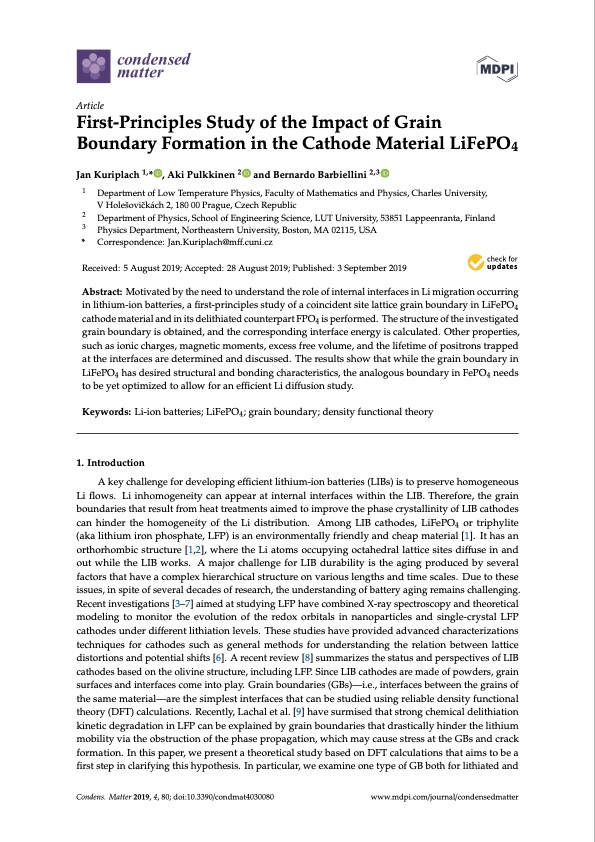
PDF Publication Title:
Text from PDF Page: 001
Article First-Principles Study of the Impact of Grain Boundary Formation in the Cathode Material LiFePO4 Jan Kuriplach 1,* , Aki Pulkkinen 2 and Bernardo Barbiellini 2,3 1 2 3 * Correspondence: Jan.Kuriplach@mff.cuni.cz Received: 5 August 2019; Accepted: 28 August 2019; Published: 3 September 2019 Department of Low Temperature Physics, Faculty of Mathematics and Physics, Charles University, V Holešovicˇkách 2, 180 00 Prague, Czech Republic Department of Physics, School of Engineering Science, LUT University, 53851 Lappeenranta, Finland Physics Department, Northeastern University, Boston, MA 02115, USA Abstract: Motivated by the need to understand the role of internal interfaces in Li migration occurring in lithium-ion batteries, a first-principles study of a coincident site lattice grain boundary in LiFePO4 cathode material and in its delithiated counterpart FPO4 is performed. The structure of the investigated grain boundary is obtained, and the corresponding interface energy is calculated. Other properties, such as ionic charges, magnetic moments, excess free volume, and the lifetime of positrons trapped at the interfaces are determined and discussed. The results show that while the grain boundary in LiFePO4 has desired structural and bonding characteristics, the analogous boundary in FePO4 needs to be yet optimized to allow for an efficient Li diffusion study. Keywords: Li-ion batteries; LiFePO4; grain boundary; density functional theory 1. Introduction A key challenge for developing efficient lithium-ion batteries (LIBs) is to preserve homogeneous Li flows. Li inhomogeneity can appear at internal interfaces within the LIB. Therefore, the grain boundaries that result from heat treatments aimed to improve the phase crystallinity of LIB cathodes can hinder the homogeneity of the Li distribution. Among LIB cathodes, LiFePO4 or triphylite (aka lithium iron phosphate, LFP) is an environmentally friendly and cheap material [1]. It has an orthorhombic structure [1,2], where the Li atoms occupying octahedral lattice sites diffuse in and out while the LIB works. A major challenge for LIB durability is the aging produced by several factors that have a complex hierarchical structure on various lengths and time scales. Due to these issues, in spite of several decades of research, the understanding of battery aging remains challenging. Recent investigations [3–7] aimed at studying LFP have combined X-ray spectroscopy and theoretical modeling to monitor the evolution of the redox orbitals in nanoparticles and single-crystal LFP cathodes under different lithiation levels. These studies have provided advanced characterizations techniques for cathodes such as general methods for understanding the relation between lattice distortions and potential shifts [6]. A recent review [8] summarizes the status and perspectives of LIB cathodes based on the olivine structure, including LFP. Since LIB cathodes are made of powders, grain surfaces and interfaces come into play. Grain boundaries (GBs)—i.e., interfaces between the grains of the same material—are the simplest interfaces that can be studied using reliable density functional theory (DFT) calculations. Recently, Lachal et al. [9] have surmised that strong chemical delithiation kinetic degradation in LFP can be explained by grain boundaries that drastically hinder the lithium mobility via the obstruction of the phase propagation, which may cause stress at the GBs and crack formation. In this paper, we present a theoretical study based on DFT calculations that aims to be a first step in clarifying this hypothesis. In particular, we examine one type of GB both for lithiated and Condens. Matter 2019, 4, 80; doi:10.3390/condmat4030080 www.mdpi.com/journal/condensedmatterPDF Image | First-Principles Grain Boundary Formation in the Cathode Material LiFePO4

PDF Search Title:
First-Principles Grain Boundary Formation in the Cathode Material LiFePO4Original File Name Searched:
condensedmatter-04-00080.pdfDIY PDF Search: Google It | Yahoo | Bing
Sulfur Deposition on Carbon Nanofibers using Supercritical CO2 Sulfur Deposition on Carbon Nanofibers using Supercritical CO2. Gamma sulfur also known as mother of pearl sulfur and nacreous sulfur... More Info
CO2 Organic Rankine Cycle Experimenter Platform The supercritical CO2 phase change system is both a heat pump and organic rankine cycle which can be used for those purposes and as a supercritical extractor for advanced subcritical and supercritical extraction technology. Uses include producing nanoparticles, precious metal CO2 extraction, lithium battery recycling, and other applications... More Info
| CONTACT TEL: 608-238-6001 Email: greg@infinityturbine.com | RSS | AMP |